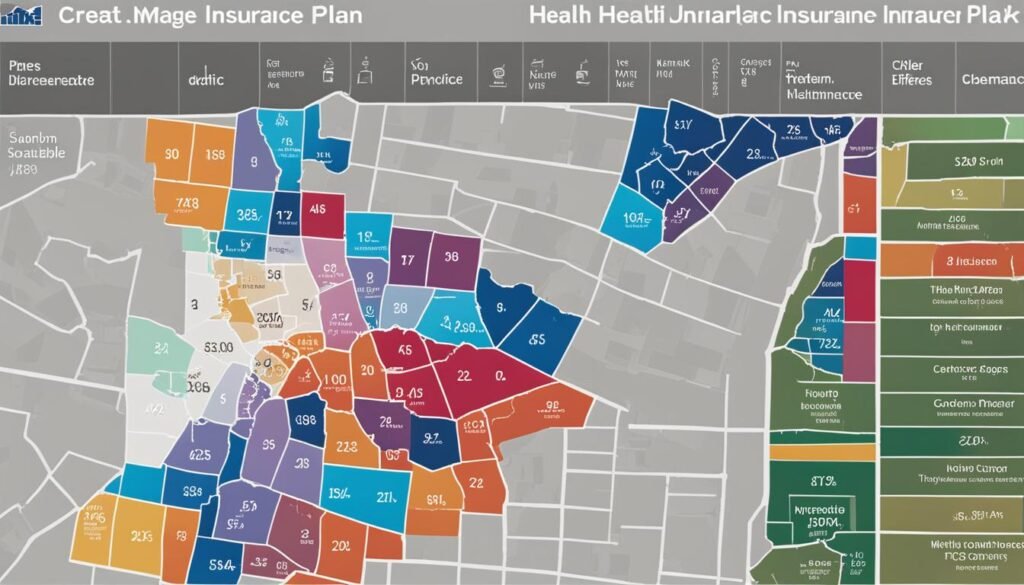Welcome to our guide on understanding health insurance in Texas! Whether you’re a resident of the Lone Star State or planning to move here, it’s important to have a solid grasp of health insurance basics, the different plans available, and the regulations governing the Texan healthcare system.
Health insurance plays a crucial role in safeguarding your financial well-being and ensuring that you have access to the necessary medical care. In Texas, there are numerous avenues for obtaining health insurance, including through your employer, government programs like Medicaid or Medicare, or individual plans. Understanding the costs, types of plans, and coverage options is key to making informed decisions regarding your health insurance in Texas.
Key Takeaways:
- Health insurance is essential for protecting your financial well-being and accessing necessary medical care in Texas.
- There are various ways to obtain health insurance in Texas, including through your job, government programs, or individual plans.
- Understanding the cost of health insurance plans in Texas is crucial for budgeting and selecting the right coverage.
- Texas offers different types of health insurance plans, such as HMO, EPO, PPO, and point-of-service plans, each with its own features and limitations.
- Health insurance plans in Texas cover a wide range of medical services, including preventive care and prescription drugs.
How to Obtain Health Insurance in Texas
When it comes to getting health insurance in Texas, there are multiple options available to meet your needs. Whether you’re employed, a college student, or looking for government assistance, understanding the various avenues can help you make an informed decision. Here are some ways you can obtain health insurance in Texas:
- Through your job or your spouse’s job: Many employers offer health insurance benefits to their employees and their dependents. If you’re employed or your spouse is, check with your employer or your spouse’s employer to see if they offer health insurance coverage.
- Parent’s plan until you turn 26: Under the Affordable Care Act, you have the option to stay on your parent’s health insurance plan until you reach the age of 26.
- Government programs: Texas has several government programs that provide health insurance options. These include the Children’s Health Insurance Program (CHIP), Medicaid for low-income individuals and families, and Medicare for individuals aged 65 and older or with certain disabilities.
- College student plan: If you’re a college student, your college or university may offer a student health insurance plan. It’s worth checking with your school to see if they have any options available.
- Membership association, union, or church: Some organizations, memberships associations, unions, or churches provide health insurance options to their members or employees. If you’re part of any such group, inquire about the available health insurance options.
- Insurance company or agent: You can directly contact an insurance company or agent who specializes in health insurance to explore the different plans they offer. They can help you find a plan that suits your needs and budget.
- Federal health insurance marketplace: The federal health insurance marketplace, known as Healthcare.gov, is an online platform where you can compare and enroll in health insurance plans. It’s especially useful if you’re in search of individual or family coverage.
Understanding the health insurance options available to you in Texas is essential for getting the right coverage. Consider your eligibility criteria and compare the different plans to find the one that best fits your needs and budget.
Source: First source
Cost of Health Insurance Plans
The cost of health insurance plans in Texas can vary based on several factors. These include age, location, smoking status, and whether the coverage is for an individual or a family. When evaluating the cost of health plans, it’s essential to consider various components, including premiums, deductibles, copayments, and coinsurance.
Premiums are the monthly fees paid for health insurance coverage. They can vary depending on the level of coverage and the insurance provider. Higher coverage levels often come with higher premium costs.
Deductibles are the amount you must pay out-of-pocket before your insurance starts covering your healthcare expenses. Lower deductible plans tend to have higher premium costs.
Copayments are fixed amounts you pay for certain services, such as doctor visits or prescription medications. Copayments can vary depending on the type of service and the insurance plan.
Coinsurance is the percentage of the cost you are responsible for once you’ve met your deductible. For example, if your plan has a 20% coinsurance rate, you would pay 20% of the covered services, while the insurance company would pay the remaining 80%.
Understanding these out-of-pocket expenses is crucial for assessing the true cost of health insurance plans. By comparing premiums, deductibles, copayments, and coinsurance rates, you can determine the financial implications of each plan option and choose the one that aligns with your budget and healthcare needs.
Comparing Health Insurance Costs
When considering health insurance plans in Texas, it’s beneficial to compare the costs of different options. Here’s an example of a cost comparison table:
| Plan | Premiums | Deductible | Copayments | Coinsurance |
|---|---|---|---|---|
| Plan A | $300/month | $1,500 | $30 for primary care visits $50 for specialist visits |
20% |
| Plan B | $200/month | $3,000 | $40 for primary care visits $60 for specialist visits |
30% |
| Plan C | $400/month | $1,000 | $20 for primary care visits $40 for specialist visits |
10% |
This table compares three hypothetical health insurance plans: Plan A, Plan B, and Plan C. It includes the monthly premiums, deductibles, copayments for primary care and specialist visits, and the coinsurance rate. By reviewing this information, you can make an informed decision based on your budget and healthcare needs.
Remember that the cost of health insurance plans is just one aspect to consider. It’s also important to evaluate the coverage, network of providers, and additional benefits offered by each plan.

Types of Health Insurance Plans in Texas
When it comes to health insurance coverage in Texas, there are several options to choose from. Understanding the different types of health plans available can help you make an informed decision about which plan best suits your needs. Let’s explore the four main types of health insurance plans in Texas:
- HMO (Health Maintenance Organization) plans: These plans typically require you to select a primary care physician (PCP) who acts as your main point of contact for all healthcare needs. Referrals from your PCP are usually necessary to see specialists or receive specialized care.
- EPO (Exclusive Provider Organization) plans: EPO plans have a network of healthcare providers that you must use to receive full benefits. However, no referrals are needed to see specialists in-network, giving you more flexibility than an HMO plan.
- PPO (Preferred Provider Organization) plans: PPO plans offer flexibility in choosing healthcare providers. You can see both in-network and out-of-network providers, although staying in-network will usually result in lower out-of-pocket costs.
- Point-of-Service plans: Point-of-Service plans combine features of both HMO and PPO plans. You have the option to choose a primary care physician and receive referrals for specialized care, similar to an HMO. However, you also have the flexibility to see out-of-network providers, like a PPO plan, although this may come with higher costs.
Each type of plan has its own set of characteristics and restrictions. It’s important to consider factors such as your preferred level of provider choice, flexibility, and budget when selecting a health insurance plan. Now, take a closer look at the table below for a side-by-side comparison of these health insurance plan types:
| Plan Type | Key Features | Provider Network | Referrals |
|---|---|---|---|
| HMO | Requires a PCP, referrals for specialists | Network-based providers | Required |
| EPO | No referrals for in-network specialists | Network-based providers | Not required |
| PPO | In-network and out-of-network coverage | Both in-network and out-of-network providers | Not required |
| Point-of-Service | Choice of PCP with referrals, out-of-network coverage | Both in-network and out-of-network providers | Required for specialists |
Understanding the differences between these health insurance plan types can help you select the right one for your healthcare needs. Consider factors such as the network of providers, the need for referrals, and the level of flexibility that suits your preferences. Now that you have a better understanding of the types of health insurance plans available in Texas, you can make an informed decision when choosing your coverage.
What Health Insurance Plans Cover
Health insurance coverage is designed to provide financial protection and access to essential medical services. Understanding what medical services are covered by your health insurance plan is crucial for making informed decisions about your healthcare. Here’s an overview of the common medical services that health insurance plans typically cover:
Doctor’s Visits
Health insurance plans typically cover visits to primary care physicians and specialists. These visits can include routine check-ups, consultations, and follow-up appointments. Coverage may vary depending on the plan, so it’s important to review the summary of benefits to understand any applicable copayments or limitations.
Hospital Stays
In the event of a hospitalization, health insurance plans generally cover the costs associated with inpatient care, including room and board, surgeries, and necessary medical procedures. Coverage may also extend to outpatient services provided within a hospital setting.
Preventive Care
Preventive care services, such as vaccinations, screenings, and annual wellness exams, are an essential component of health insurance coverage. These services are designed to detect and prevent potential health issues before they become more severe. Under the Affordable Care Act, many preventive care services are covered without any out-of-pocket costs for insured individuals.
Prescription Drugs
Health insurance plans typically include coverage for prescription medications. This can include both generic and brand-name drugs, although the specific coverage and copayment amounts may vary depending on the plan formulary. It’s important to review your plan’s prescription drug coverage to understand any limitations or requirements, such as prior authorization or step therapy.
These are just a few examples of the medical services that health insurance plans commonly cover. It’s essential to read and understand the details of your specific plan, as coverage can vary. By reviewing the summary of benefits and coverage, you can ensure that you have a clear understanding of the medical services that are included and any associated costs or limitations.

Comparing Medical Services Covered by Different Health Insurance Plans
| Health Insurance Plan | Doctor’s Visits | Hospital Stays | Preventive Care | Prescription Drugs |
|---|---|---|---|---|
| Plan A | ✓ | ✓ | ✓ | ✓ |
| Plan B | ✓ | ✓ | ✓ | ✓ |
| Plan C | ✓ | ✓ | ✓ | ✓ |
This table provides a high-level comparison of different health insurance plans with regards to the medical services they cover. It’s important to note that this is just a simplified representation, and actual plan details may vary. When selecting a health insurance plan, it’s recommended to carefully review the plan’s summary of benefits and coverage to ensure it aligns with your healthcare needs.
Resolving Disputes About Your Health Plan
If you find yourself in a dispute or disagreement with your health insurance plan, there are established processes in place to help you resolve the issues. Resolving health plan disputes involves navigating the appeals process and complaint process, which can ensure that you receive the coverage and care you are entitled to under your health insurance plan.
Appeals Process
If you believe that your health insurance plan has wrongly denied coverage for a treatment, medication, or service, you have the right to file an appeal. The appeals process allows you to challenge the decision and present evidence in support of your case. Here are the key steps to follow:
- Contact your insurance company: Begin by contacting your insurance company to understand their specific appeals procedures. Request a copy of their appeals policy and any necessary forms.
- Gather supporting documentation: Collect all relevant medical records, test results, and any other evidence that supports your claim for coverage.
- Complete the appeals process: Submit your appeal within the designated timeframe, ensuring that you provide all the necessary information and documentation. Keep copies of everything for your records.
- Follow up: Stay in contact with your insurance company to track the progress of your appeal. Ask for updates and clarification if needed.
- Utilize external resources: If your appeal is not successful, you may have the option to seek assistance from external resources, such as state insurance departments or independent review organizations, to further evaluate your case.
Remember, it is crucial to familiarize yourself with your insurance plan’s appeals procedures and comply with the specified timelines. By understanding and following the appeals process, you can maximize your chances of resolving disputes and receiving the coverage you need.
Complaint Process
In addition to the appeals process, you can also file a formal complaint against your health insurance plan if you believe it is not meeting its obligations. Filing a complaint can draw attention to a pattern of issues and potentially trigger regulatory action. Here are the general steps involved:
- Identify the appropriate regulatory agency: Research the regulatory agency responsible for overseeing health insurance plans in your state. This is typically the department of insurance or a similar entity.
- Gather evidence: Document the specific incidents or instances that have led to your complaint. Include any supporting documentation that highlights the non-compliance or misconduct.
- File the complaint: Submit your complaint to the relevant regulatory agency, following their specified procedures. Be sure to include all necessary details and supporting documentation.
- Cooperate with the investigation: If your complaint is taken up by the regulatory agency, cooperate fully with their investigation. Provide any additional information or documentation they may request.
- Follow up: Stay informed about the progress of your complaint and any actions taken by the regulatory agency. Be prepared to provide further information or participate in hearings if required.
Resolving health plan disputes through the complaint process can contribute to better accountability and improve the overall quality of health insurance services. However, it’s important to remember that the complaint process may take time, so it’s advisable to seek the assistance of a legal professional or patient advocacy organizations if necessary.
| Benefits | Appeals Process | Complaint Process |
|---|---|---|
| Provides a formal method to challenge denial of coverage | Allows you to present evidence in support of your case | Draws attention to non-compliance or misconduct by the insurance plan |
| Increases chances of receiving the coverage you need | Offers the possibility of utilizing external resources for further evaluation | Contributes to better accountability and quality of services |
| Note: The appeals process and complaint process vary by insurance company and regulatory agency. Familiarize yourself with your specific plan’s procedures and consult the relevant agency for guidance. | ||
Your Rights as a Health Insurance Consumer in Texas
As a health insurance consumer in Texas, it’s important to be aware of your rights and protections. Understanding these rights can help you navigate the complex landscape of health insurance, ensuring that you receive fair treatment and access to necessary care. Here are the key rights you have as a health insurance consumer in Texas:
- Privacy and Confidentiality: You have the right to privacy and confidentiality of your medical information. Your health insurance provider must protect your personal health information and cannot disclose it without your consent, except as permitted by law. This protection ensures that your sensitive information remains secure and confidential.
- Appeal Denied Claims: If your health insurance claim is denied, you have the right to appeal the decision. This means you can challenge the denial and provide additional information or evidence to support your claim. The appeals process allows for a fair review of your case and gives you the opportunity to advocate for the coverage you believe you deserve.
- Transparent Information: You have the right to receive clear and transparent information about your health insurance coverage. This includes details about covered medical services, limitations or exclusions, and any cost-sharing responsibilities such as deductibles, copayments, and coinsurance. Having access to this information empowers you to make informed decisions about your healthcare and understand the financial implications of your coverage.
By understanding and asserting your rights as a health insurance consumer in Texas, you can ensure that you receive the necessary protections and access to quality care. Remember that these rights are designed to safeguard your well-being and provide you with the support you need when navigating the healthcare system. Exercise your rights and advocate for yourself to make the most of your health insurance coverage.

Shopping for Health Insurance in Texas
When it comes to shopping for health insurance in Texas, there are a few important factors to consider. Comparing different plans is crucial to ensure you find the coverage that aligns with your needs and budget. Here are some key points to keep in mind:
1. Coverage
Examine the coverage options offered by different health insurance plans. Look for plans that include the medical services you need, such as doctor’s visits, hospital stays, preventive care, and prescription drugs. Ensure that any specific healthcare needs or conditions you have are covered by the plan.
2. Cost
Consider the cost of health insurance plans, including premiums, deductibles, copayments, and coinsurance. Determine how much you can afford to pay each month for your health insurance premium, as well as the out-of-pocket costs you may incur when receiving medical services. Evaluate the potential financial impact of different plans on your budget.
3. Network of Providers
Check the network of healthcare providers that are covered by each health insurance plan. Make sure that your preferred doctors, specialists, hospitals, and other healthcare facilities are part of the plan’s network. Access to your preferred providers can make a big difference in receiving quality care.
4. Additional Benefits
Explore any additional benefits offered by different health insurance plans. Some plans may include perks like dental, vision, or mental health coverage. Others may offer wellness programs or discounts on gym memberships. Consider these added benefits to enhance your overall healthcare experience.
Once you’ve gathered all the necessary information and compared the different health insurance plans, it’s time to enroll in a plan. The Open Enrollment Period is the designated time to enroll in or make changes to your health insurance coverage. In Texas, this period typically occurs from November 1 to December 15 each year.
During this period, you can visit the federal health insurance marketplace or contact an insurance company or agent to enroll in a plan or make changes to your existing coverage. It’s important to act within the designated timeframe to ensure you have the health insurance coverage you need.
Shopping for health insurance can seem overwhelming, but by considering factors such as coverage, cost, network of providers, and additional benefits, you can make informed decisions that align with your healthcare needs. Take advantage of the Open Enrollment Period to secure the right coverage for you and your family.

Key Considerations When Shopping for Health Insurance in Texas
| Considerations | Description |
|---|---|
| Coverage | Ensure the plan includes the medical services you need |
| Cost | Evaluate premiums, deductibles, copayments, and coinsurance |
| Network of Providers | Check if your preferred doctors and healthcare facilities are covered |
| Additional Benefits | Explore perks like dental, vision, mental health coverage, and wellness programs |
Losing Your Health Insurance Coverage in Texas
If you find yourself losing your health insurance coverage in Texas due to job loss, marriage, or other qualifying events, it’s crucial to understand the available options to ensure you maintain health insurance protection. Two key options to consider are COBRA coverage and special enrollment periods.
COBRA Coverage:
If you lose your job or experience a reduction in work hours, you may be eligible for COBRA coverage. COBRA, which stands for Consolidated Omnibus Budget Reconciliation Act, allows you to continue your employer-sponsored health insurance plan for a limited period, typically up to 18 months. This option provides temporary coverage, giving you time to explore alternative options.
Special Enrollment Periods:
In addition to COBRA coverage, losing your health insurance coverage may also trigger a special enrollment period. These periods are designed to provide individuals and families with a chance to enroll in new coverage outside of the regular open enrollment period. Qualifying events that trigger a special enrollment period can include losing your job, getting married, having a baby, or moving to a new area.
During a special enrollment period, you can explore different coverage options and choose a plan that suits your needs. It’s important to note that special enrollment periods typically have time limitations, so it’s crucial to act promptly to avoid any gaps in health insurance protection.
If you need assistance or have questions about COBRA coverage or special enrollment periods, it’s best to reach out to your employer’s human resources department, an insurance agent, or visit the official Texas health insurance marketplace for guidance.
“Losing your health insurance coverage can be a stressful experience, but understanding the available options and taking timely action can help you maintain essential health insurance protection.” – [Insert Expert Name]
To help you navigate the process, here’s a table summarizing the key differences between COBRA coverage and special enrollment periods:
| Option | Key Features | Eligibility | Time Limit |
|---|---|---|---|
| COBRA Coverage | Continuation of employer-sponsored plan | Job loss or reduction in work hours | Up to 18 months |
| Special Enrollment Periods | Opportunity to enroll in new coverage | Losing current coverage or experiencing qualifying life events | Varies depending on the qualifying event |
When faced with losing your health insurance coverage, understanding your options and taking proactive steps can help ensure continuous coverage and peace of mind.

Programs That Can Help with Health Insurance in Texas
Obtaining affordable health insurance coverage can be a challenge, but Texas offers several assistance programs to support individuals and families in accessing the care they need. These programs are designed to provide financial aid and coverage options for those in need, ensuring that healthcare remains accessible and affordable for Texans.
1. Medicaid
Medicaid is a state and federal program that offers health insurance to low-income individuals and families. Eligibility is based on income and other factors, and it provides comprehensive coverage for medical services, including doctor visits, hospital stays, prescription drugs, and more. Medicaid is an invaluable resource for those who may not qualify for other insurance options.
2. CHIP (Children’s Health Insurance Program)
CHIP provides health insurance for uninsured children in Texas. This program extends coverage to children in families who earn too much to qualify for Medicaid but cannot afford private insurance. CHIP offers comprehensive benefits, including doctor visits, immunizations, dental care, and prescription medications. Ensuring that children have access to quality healthcare is essential for their growth, development, and overall well-being.
3. Premium Tax Credits
For individuals and families who do not qualify for Medicaid or CHIP but still need help affording health insurance, premium tax credits can provide assistance. These credits, available through the federal health insurance marketplace, help lower monthly premiums, reducing the financial burden of insurance costs. Eligibility is based on income, and these credits can significantly reduce the overall cost of health insurance plans.
By understanding these programs and their eligibility requirements, individuals and families in Texas can access the necessary support to obtain affordable health insurance coverage. Whether through Medicaid, CHIP, or premium tax credits, these programs are invaluable resources for those who need assistance navigating the complex healthcare landscape.

| Program | Eligibility | Benefits |
|---|---|---|
| Medicaid | Low-income individuals and families | Comprehensive coverage for medical services |
| CHIP | Uninsured children in low-income families | Doctor visits, immunizations, dental care, prescription medications, and more |
| Premium Tax Credits | Income-based eligibility | Lower monthly premiums for health insurance plans |
Conclusion
Understanding health insurance in Texas is crucial for navigating the complexities of the healthcare system and making informed decisions about coverage. By familiarizing yourself with the basics, including how to obtain health insurance and the different types of plans available, as well as considering factors such as cost, coverage, and your rights as a consumer, you can confidently select a health insurance plan that meets your needs.
Having the right health insurance coverage provides important financial protection and ensures access to necessary medical care in Texas. By carefully evaluating your options and understanding the details of your health insurance plan, you can safeguard your financial well-being and have peace of mind knowing that you are covered in case of medical emergencies or unexpected health issues.
Make use of the resources available to you, such as reputable insurance providers and government programs like Medicaid or CHIP, to find the best health insurance guidance and support. Educate yourself about the various plans, their benefits, and their limitations. By doing so, you can make informed decisions that prioritize your health and well-being, while also taking into account your budget and unique healthcare needs.








